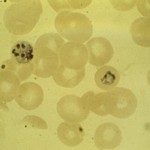Link to Pubmed [PMID] – 2948733
Circ Res 1986 Nov; 59(5): 551-5
Cardiac hypertrophy due to a chronic hemodynamic overload is accompanied by isoformic changes of two proteins of the thick filament of the sarcomere, myosin, and creatine phosphokinase. We have looked for isoactin changes, using deoxyribonucleic acid probes complementary to alpha-skeletal and alpha-cardiac actin messenger ribonucleic acids. Three groups of rats were studied at various days after application of a pressure overload (2-4 days, n = 13, 8-15 days, n = 5, and 30-40 days, n = 7) and were compared to control animals (n = 11). Whereas alpha-skeletal actin messenger ribonucleic acids were hardly detectable in the normal hearts (0.6 +/- 0.16%), they accumulated significantly in the first 4 days after the aortic stenosis (4.6 +/- 3.1%, p less than 0.001 vs. controls) and then slowly declined (8-15 days, 3.2 +/- 1.7% and 30-40 days, 1.6 +/- 0.6%, p less than 0.05 and NS vs. controls). This figure is similar to that observed in 8-day-old rats (2.27 +/- 0.3%, p less than 0.01 vs. controls). We conclude that, in rat myocardium, the expression of messenger ribonucleic acids encoding the sarcomeric actins is altered at the onset of a pressure overload hypertrophy. Although the physiological significance of isoactin changes is unknown, our results show that the thin filament participates as well as the thick filament in the response of cardiac muscle to new functional requirements.

